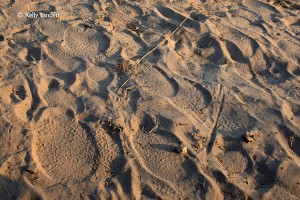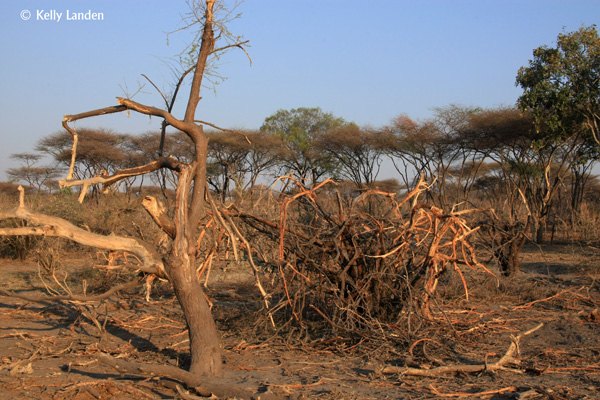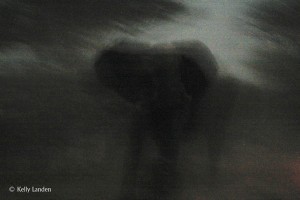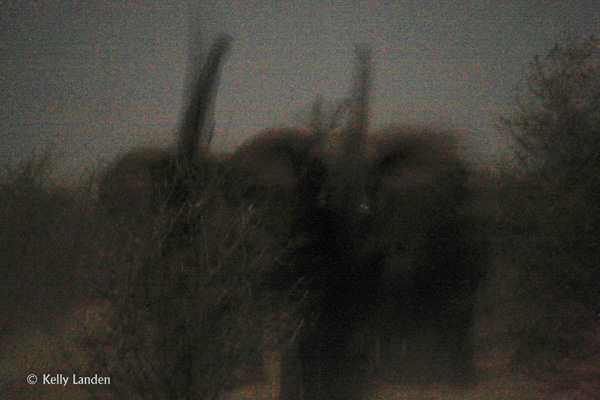Evening in an Elephant Corridor
Wildlife or habitat corridors are traditionally categorized by their size into either Regional, Sub-regional or Local. This weekend, driving out to EWB’s conservation farming project, we took a different route than our usual and came across an amazing small, local “corridor” that elephants have recently created.

elephant tracks in the corridor
The Chobe enclave has been well-known and documented as an area of considerable elephant movement and human-elephant conflict. The villages in the enclave sprawl across the easiest access points to water and flood plain grasslands from the pristine mixed-mopane woodlands of the Chobe Forest Reserve, in which elephants congregate in high numbers. With this in mind, one can easily assess why there would be competition for land use between people and elephants in that region. However, elephants are resilient and either adjust their movements or simply tolerate having to share space. This might be tolerable for the elephants, but for people in the villages, it can be frightful. (read abut EWB’s elephant and people projects: www.elephantswithoutborders.org/living_with_elephants.php
Presently, a large tarred road is under construction stretching approx. 60 kilometers from Chobe National Park’s Ngoma gate to the village of Kachikau. With this new huge development, the elephants have “adjusted” their movements just slightly beyond the villages to access water and nutrient rich grasses. Throughout the night, they come down the corridor, only to return to the forests in the early morn. This small corridor is only 1 kilometer wide, and perhaps 10 kilometers long. (Want to read more about our projects and progress see: www.elephantswithoutborders.org/downloads.php)

vegetation takes slack from consistent use by elephants
It was easy to demarcate the corridor by the remains of trees and vegetation destroyed in the wake of consistent elephant use.
We talked to some of the local people who settled beyond the villages, who had first hand knowledge of the elephants’ movement patterns. Following a herd boys’ lead, we planted ourselves on the fringe of the corridor, just after sunset. With the loss of the sun came a hint of moonlight, so we sat in silence waiting. At first, we thought perhaps we had missed the elephants coming through, we were too late. But patience paid off and we suddenly heard the sound of rustling. Then, we could hear the soft shuffling sounds of elephant steps.

soft shadows is all we could see in the dust
Squinting, I was scanning the darkness to catch a glimpse of dark shadows, when Mike exclaimed “look behind us!” Twenty meters from the back of our Landy, I could see a parade of dark, hurried shadows running to the water… a breeding herd, more than 50 strong splashed into the cool water. “Ssshhh!’ Parallel to our side, large ears protruded from the shrub only 5 meters away. The large matriarch smelled us and hesitated, shifting from one foot to the next, then with a shake of her massive head, she quickly moved around the vehicle, leading another 30 elephants behind her. Dust filled our nostrils, ears and eyes, but we kept them wide-open, anxiously looking through the haze for more. We realized we weren’t on the edge of the corridor, we were right in the middle of it! A herd crossed beyond the hood of the car, and then another came from the side. They kept coming, and coming. Occasionally a feisty young one would hesitate and hover over us, trunk up sniffing, before moving on. Hundreds of elephants passed around our vehicle on their evening routine to fresh water and food. We carried a large searchlight, however, we thought best to not disturb them. I imagined that these particular elephants already had to run a gamut around people and harassment. They chose their route and timing carefully. So instead, as the dust settled, we relied on our ears and listened intently to the slurping, splashing and finally the sound of massive water movement. The elephants moved on… and yes, to greener pastures until the wake of the sun.
Support Elephants Without Borders endeavors, by logging on to: www.elephantswithoutborders.org/donate.php

Shadows of elephants surrounded our vehicle
Tags: africa, botswana, chobe, conservation, elephants, elephants without borders, human-elephant conflict, people, research, wildlife







